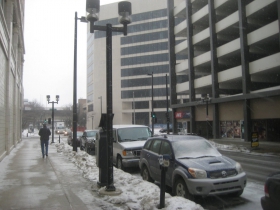Sculpture Disappears from Downtown
The 36-foot-high, $200,000 work was installed by Blue Cross in 1978; new owner of property won't reply to calls, artist has no idea what happened to sculpture.

The sculpture, “Peter John,” is visible, on the left side of the plaza, in this photo of 401 W. Michigan St.
Photo taken January 23rd, 2015 by Jeramey Jannene.
A 36-foot steel sculpture that anchored the plaza at 401 W. Michigan St. since 1978 disappeared from its prominent perch at some time within the past month. Its fate is unknown, but a pair of dumpsters parked outside the former Blue Cross Blue Shield headquarters, where the sculpture had been located, provide an ominous portent.
The Brutalist-style building, vacant since 2006, is undergoing conversion to 200 apartment units and will be known as The 401.
The sculpture, “Peter John,” was commissioned by the insurance giant as a site-specific work to complement the building. The $200,000 commission was awarded to a 30-year old sculptor John Raimondi, who designed a 36ft. x 27ft. x 13ft. angular counterpoint to the severe architecture of the 11-story, 200,000-plus square foot building, taking into account the building’s beveled facade, a triangular plaza where the sculpture rested, and the large scale of the buildings in the area. The 1970s was the high point for monumental geometric minimalism in sculpture.
So, after 38 years in place, where did it go?
John Mangel, the developer of the apartment conversion, did not respond by telephone or email to requests for comment on what happened to the sculpture. Nor was anybody on site during a visit Friday afternoon.
If the thing had been whisked away to a factory for conservation, or relocated to a sculpture garden somewhere, Mangel probably would have been the first to say so. So, his silence is not good news.
The move took the sculptor by surprise, Raimondi tells Urban Milwaukee. And he’s not happy about it.
“I’m sure they destroyed it,” he said in a telephone message from his studio in Palm Beach Gardens Florida. He has produced over 100 “monumental” works of sculpture in 30 states. “Peter John” dates from Raimondi’s early “Geometric Minimalism” series of the 1970s. The sculpture is named in honor of his father.
Could things have been handled differently? Yes, says Raimondi. “It’s too bad they didn’t reach out to me. I would have loved to buy that sculpture back.”
Raimondi says he would have gladly spent his own money to buy the sculpture back. Apparently, that simple win-win solution never occurred to the developer. And now, we are all losers, save perhaps Miller Compressing Co or some other junkyard or recycler.
Raimondi added via e-mail, “how sad and counterproductive. I’m one of the easiest people to reach via the internet. If the developer had contacted me, I would have had an opportunity to sell the sculpture, buy it back or help with the donation to the [Lynden] Sculpture Garden.
“In 2 years we would have celebrated [its] 40 year anniversary. The Milwaukee [Art Museum] owns the bronze model.” Raimondi created a bronze maquette or model which the museum owns.
“They could have donated to so many people, instead they just destroyed a monumental sculpture?”
Polly Morris, the director of Lynden, the sculpture garden in River Hills that is run by the Bradley family foundation and houses one of the nation’s principal repositories of Monumental and Geometric Minimalist sculptures at Lynden, says she had learned that Mangel, the developer, did not care for the sculpture and wanted to get rid of it.
But when Morris reached out to him, she said, he did not respond to her calls.
Lynden, she stressed, does not have a budget to rescue every threatened sculpture, but with its unparalleled contacts, it could help in a search for a home for the piece.
Morris, too, is not sanguine about the sculpture’s future. Whatever Mangel has done with it, she adds, “a living artist should always be contacted” in such a case. Who knows? They might want to buy it back!
Also expressing regret at the apparent destruction of the sculpture is Barbara Brown Lee, a long-time director of education at the Milwaukee Art Museum. “It was a good one by a good sculptor,” she says.
If Mr. Mangel, the developer, hopes to hit the sweet spot demographic for his new upscale apartment renovation, he certainly doesn’t care as much about appealing to students of art history or urban design and planning. He might have kept the sculpture right where it was, and modified the plaza to be more accommodating to residents of an apartment building, rather than its original use as a place to funnel workers inside and outside of an office building.
It is unknown what is to replace the sculpture, if anything. A rendering of the building, shown on the website of contractor Tri-North (“Build Smart”), is of the west elevation only, and was of no help. (The sculpture was on the east face of the building.) It also doesn’t help matters that the project is mistakenly called “401 Michigan Avenue” by the contractor. (There is no Michigan Avenue in Milwaukee; it’s Michigan St.)
If the sculpture had been in disrepair, or damaged beyond repair, it would have been a small matter to have said so. Even the fabled Lynden Sculpture Garden has had to trash a Cor-Ten sculpture due to corrosion. A construction accident could have been explained — after all, a contractor at the Milwaukee Art Museum once accidentally scrapped a minimalist monumental sculpture by Alexander Liberman.
Indeed, a visit to the site shows no sign of corrosion or other defects at the base of what had been the three-piece work. The work was engineered to sit on a pan that drained any corrosion from the statue. “We did that so the plaza would not get stained with rust,” Raimondi said. They needn’t have bothered if the sculpture had been cast in bronze, “but Blue Cross didn’t have money for that.”
We still have enough unsolved 20th century sculptural mysteries (where is Germania? Where is the Courthouse Fountain?). We certainly didn’t need to add a 21st century one to the mix.
Fun Fact: The sculpture resulted from a most unusual commission. The funds for the project came from a bequest to the insurance company made under the will of a customer. A plaque that on the site of the sculpture read:
“PETER JOHN/Cor-Ten steel/John Raimondi, Sculptor/Bequest from John Whipperfield/Subscriber to Blue Cross of Wisconsin/and Surgical Care – Blue Shield/June 1978.“
The location of the plaque today is unknown. Its scrap value, if bronze, would be about $15.
Not His First Loss
Raimondi also lost a 39 foot bronze that had been at the Palm Beach Opera House, and then put into storage for a number of years. When the cost of storage became too high for the trustees, they decided to sell the thing and cut it up into pieces.
Raimondi is suing under a federal law that protects certain works of art made after 1990. He says he will file the papers sometime next week. As for this piece, he has no recourse.
What Did You See?
The site is in plain view of hundreds of apartments, offices and hotel rooms. If any reader witnessed the deconstruction of the sculpture, please feel free to contact this writer.
Site of Peter John Sculpture
Plenty of Horne
-
Villa Terrace Will Host 100 Events For 100th Anniversary, Charts Vision For Future
 Apr 6th, 2024 by Michael Horne
Apr 6th, 2024 by Michael Horne
-
Notables Attend City Birthday Party
 Jan 27th, 2024 by Michael Horne
Jan 27th, 2024 by Michael Horne
-
Will There Be a City Attorney Race?
 Nov 21st, 2023 by Michael Horne
Nov 21st, 2023 by Michael Horne





























I have zero faith that this project will be well-executed. Building design seems to be a total non issue.
You couldn’t say the sculpture got ‘Plankintoned’ since it wasn’t damaged, then removed as that Grand property was. I guess you’d have to say the sculpture got ‘Mangled’?
sounds like an issue for Poirot!
The Federal Visual Artists Rights Act of 1990 makes it illegal to destroy a work of art. Moving it, selling it, putting it in storage – all fair. Destroying it violates the intellectual property of an artist. Raimondi has the right to sue the developer if that has happened. Check out the details.
http://www.law.harvard.edu/faculty/martin/art_law/esworthy.htm
http://en.wikipedia.org/wiki/Visual_Artists_Rights_Act
Eyesore art finds a dumpster. Overpaid artist sad. It’s a start.
It ( is, was) a Bad Ass sculpture , severe in composition, it reminded me of a scalpel, though I did like it, a daily diet I think not. Too strong….
If it still exists, perhaps we should rotate art around town and drop this one in lets say, in front of the federal building, or the police department, or some medical facility were they like to cut.
Well I love a mystery, I think this one will be short lived……….
Blue Cross Blue Shield of Wisconsin was a client for many years of the public relations firm known then as Barkin Herman Solochek & Paulsen. I was in charge of organizing the sculpture project’s selection committee. John Lloyd “Jack” Taylor, who had been curator of contemporary art at the Milwaukee Art Museum and then at the University of Wisconsin-Milwaukee, headed that committee of art professionals. It was a several year project before Mr. Raimondi was selected, and then created “Peter John.” What a shocking waste this is, when it so easily could have been saved and placed elsewhere.
Knowing Wrong-way Walker’s disdain for public art, he’s sure to be involved somehow.
Probably some dumb job superintendent is responsible. Thought he’d get points from his boss.
Plenty of people saw it get removed. Anyone who wants to get details should first ask the employees at Avis, Boston Store, or the guys who park cars for the Courtyard Marriott.
Or just ask some of the bums who congregate on the benches at Zeidler Park. There are always a few there, and they are actually polite/non-aggressive ones.
Security cameras at any of those places or in the parking ramp above Avis would have likely captured some telling images.
Bottom line, it was certainly the project developer, who wanted to scrap it before asking questions to avoid the debates alluded to in this article. I love art and sculptures … but honestly, that particular one WAS dilapidated, outdated and not particularly impressive. Sorry, the rusty ”Peter John” 3-prong ain’t no Calatrava.
I would hope that the developer is not that crass as to willfully destroy the sculpture. He can’t be that much of a dullard, can he?
Milwaukee benefits from the public art we have. It adds texture and interest to the city. We need more pieces from the traditional to the avant garde.
I hope the developer has temporarily removed “Peter John” until construction is completed — but I’m afraid that my hope and reality may not match.
If the county park system had its act together, why not establish a program to selectively place orphan sculpture art in our parks? Obviously not everyone thinks highly of the “Peter John” sculpture (personally not my cup of tea), but why not place it in an appropriate, non-prominent, area of a county park that is accessible for those that may enjoy it.
Is there ANY update on this missing sculpture yet? Did Mangel mangel or melt it? Anyone know?